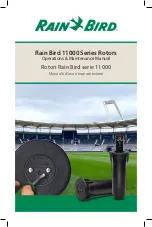
13
• If Yes, inspect end of level wand for debris or damage, replace if needed. (The float at bottom of the wand
should have free movement, up and down.
• If No, inspect wire for damage. If no damage visible inspect internal wiring. (See NO POWER TO UNIT,
POWER PRESENT AT RECEPTACLE 1 thru 10 above)
4.
If no resolution is found, record Serial / Model numbers and call customer service
LOW LEVEL ALARM STAYS ON
1.
Disconnect level wand connection and short across connectors with screw driver. (this is low voltage and not
dangerous)
2.
This turns off the alarm. There is a problem with the wand itself.
3.
Inspect the float end of the level wand.
4.
If the float is free moving replace wand.
5.
Shorting the connecter does not turn off alarm. Inspect internal wiring. (See
NO POWER TO UNIT, POWER
PRESENT AT RECEPTACLE 1 thru 10 above)
6.
Still no resolution record Model / Serial numbers and call customer service.
Maintenance
Maintenance and care will depend upon the usage and environment in which the system is subjected to.
The following is the suggested regular maintenance required to keep the glycol feed system operating
properly:
TANK AND PLUMBING
Periodically check the piping and tubing to insure proper discharge of the glycol solution. The strainer
should be periodically checked for clogging and wear. The level wand should be removed and cleaned to
prevent clogging.
GEAR PUMP
Check for proper operation. If any pump/motor noises, leaks or changes in operation are detected, the
pump should be removed and examined by a certified technician. Gear pump repairs can be difficult and
should only be attempted by qualified personnel. Improper repairs or assembly can result in pump failure
and nullification of the warranty. No lubrication is required.
PRESSURE RELIEF VALVE
Periodic checking and replacement of the adjustment seal is the only maintenance required.
Summary of Contents for GF Series
Page 11: ...11 19 Parts List ...
Page 15: ...15 ...


































